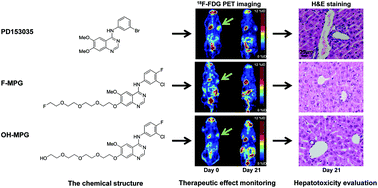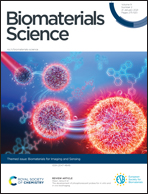Novel anilino quinazoline-based EGFR tyrosine kinase inhibitors for treatment of non-small cell lung cancer†
Abstract
The epidermal growth factor receptor (EGFR)-tyrosine kinase inhibitors (TKIs) have revolutionized the treatment of non-small cell lung cancer (NSCLC). EGFR-TKI positron emission tomography (PET) probes based on the central quinazoline core show great potential for NSCLC diagnosis, and pre-clinical and clinical therapy monitoring. In our previous research, anilino quinazoline based PET probe, N-(3-chloro-4-fluorophenyl)-7-(2-(2-(2-(2-18F-fluoroethoxy) ethoxy) ethoxy) ethoxy)-6-methoxyquinazolin-4-amine (18F-MPG), have been developed, and it has been successfully demonstrated to be a powerful non-invasive imaging tool for differentiating EGFR mutation status and stratifying NSCLC patients for EGFR-TKI treatment in a clinical study (n = 75 patients). Moreover, it has been found that 18F-MPG shows excellent tumor targeting performance and good pharmacokinetic characteristics in NSCLC patients. These results motivate us to investigate the cancer treatment efficacy of non-radioactive F-MPG and its analogue N-(3-chloro-4-fluorophenyl)-7-(2-(2-(2-(2-hydroxyethoxy)ethoxy) ethoxy) ethoxy)-6-methoxyquinazolin-4-amine (OH-MPG) in vitro and in small animal models. Our studies revealed that both F-MPG and OH-MPG displayed high therapeutic effect to NSCLC cells (IC50 = 5.3 nM and 2.0 nM to HCC827 cells for F-MPG and OH-MPG, respectively). More importantly, compared with a standard EGFR-TKI, 4-(3-bromoanilino)-6,7-dimethoxyquinazoline (PD153035), F-MPG and OH-MPG showed stronger tumor inhibition in preclinical models. Furthermore, the treatment efficacy of F-MPG or OH-MPG monitored by 18F-FDG-PET indicated that tumor uptake in treated groups was significantly decreased. Ex vivo experiments showed that the levels of serum biomarkers and pathological changes in the liver were significantly reduced in the F-MPG and OH-MPG group, compared to PD153035 treated group. In conclusion, EGFR targeted F-MPG and OH-MPG exhibit promising anti-tumor activity with limited liver damage, thus representing promising drug candidates for further investigation for combating the deadly NSCLC.

- This article is part of the themed collection: Biomaterials for Imaging and Sensing


 Please wait while we load your content...
Please wait while we load your content...